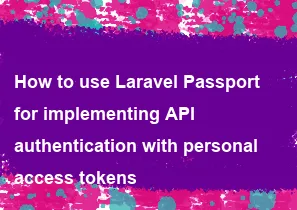How to use Laravel Passport for implementing API authentication with personal access tokens

Laravel Passport is a popular OAuth2 server for Laravel applications, which makes it easy to implement API authentication. It provides support for various grant types, including personal access tokens. Below is a step-by-step guide on how to use Laravel Passport for API authentication with personal access tokens:
Step 1: Install Passport
Install Laravel Passport using Composer:
bashcomposer require laravel/passport
Step 2: Run Migrations
Run the Passport migrations to create the necessary database tables:
bashphp artisan migrate
Step 3: Install Passport
Install Passport using the install Artisan command:
bashphp artisan passport:install
This command will generate encryption keys and create the necessary database tables for Passport.
Step 4: Configure the User Model
Make your User model implement the HasApiTokens trait:
phpuse Laravel\Passport\HasApiTokens;
class User extends Authenticatable
{
use HasApiTokens, Notifiable;
// ...
}
Step 5: Set Up the AuthServiceProvider
In your AuthServiceProvider, add the following lines to the boot method:
phpuse Laravel\Passport\Passport;
public function boot()
{
$this->registerPolicies();
Passport::routes();
}
Step 6: Create API Routes
In your routes/api.php file, define the routes that should be protected by Passport:
phpRoute::middleware('auth:api')->get('/user', function (Request $request) {
return $request->user();
});
Step 7: Create Personal Access Token
To create a personal access token, you can use the createToken method on a user instance:
php$user = User::find(1);
$token = $user->createToken('Token Name')->accessToken;
-
Popular Post
- How to optimize for Google's About This Result feature for local businesses
- How to implement multi-language support in an Express.js application
- How to handle and optimize for changes in mobile search behavior
- How to handle CORS in a Node.js application
- How to use Vue.js with a UI framework (e.g., Vuetify, Element UI)
- How to configure Laravel Telescope for monitoring and profiling API requests
- How to create a command-line tool using the Commander.js library in Node.js
- How to implement code splitting in a React.js application
- How to use the AWS SDK for Node.js to interact with various AWS services
- How to use the Node.js Stream API for efficient data processing
- How to implement a cookie parser middleware in Node.js
- How to implement WebSockets for real-time communication in React
-
Latest Post
- How to implement a dynamic form with dynamic field styling based on user input in Next.js
- How to create a custom hook for handling user interactions with the browser's device motion in Next.js
- How to create a custom hook for handling user interactions with the browser's battery status in Next.js
- How to implement a dynamic form with dynamic field visibility based on user input in Next.js
- How to implement a dynamic form with real-time collaboration features in Next.js
- How to create a custom hook for handling user interactions with the browser's media devices in Next.js
- How to use the useSWRInfinite hook for paginating data with a custom loading indicator in Next.js
- How to create a custom hook for handling user interactions with the browser's network status in Next.js
- How to create a custom hook for handling user interactions with the browser's location in Next.js
- How to implement a dynamic form with multi-language support in Next.js
- How to create a custom hook for handling user interactions with the browser's ambient light sensor in Next.js
- How to use the useHover hook for creating interactive image zoom effects in Next.js